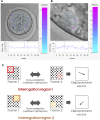How great thou ART: biomechanical properties of oocytes and embryos as indicators of quality in assisted reproductive technologies
- PMID: 38425501
- PMCID: PMC10902081
- DOI: 10.3389/fcell.2024.1342905
How great thou ART: biomechanical properties of oocytes and embryos as indicators of quality in assisted reproductive technologies
Abstract
Assisted Reproductive Technologies (ART) have revolutionized infertility treatment and animal breeding, but their success largely depends on selecting high-quality oocytes for fertilization and embryos for transfer. During preimplantation development, embryos undergo complex morphogenetic processes, such as compaction and cavitation, driven by cellular forces dependent on cytoskeletal dynamics and cell-cell interactions. These processes are pivotal in dictating an embryo's capacity to implant and progress to full-term development. Hence, a comprehensive grasp of the biomechanical attributes characterizing healthy oocytes and embryos is essential for selecting those with higher developmental potential. Various noninvasive techniques have emerged as valuable tools for assessing biomechanical properties without disturbing the oocyte or embryo physiological state, including morphokinetics, analysis of cytoplasmic movement velocity, or quantification of cortical tension and elasticity using microaspiration. By shedding light on the cytoskeletal processes involved in chromosome segregation, cytokinesis, cellular trafficking, and cell adhesion, underlying oogenesis, and embryonic development, this review explores the significance of embryo biomechanics in ART and its potential implications for improving clinical IVF outcomes, offering valuable insights and research directions to enhance oocyte and embryo selection procedures.
Keywords: assisted reproductive technologies; biomechanics; cytoskeleton; embryo; mouse; oocyte; preimplantation development; quality assessment.
Copyright © 2024 Fluks, Collier, Walewska, Bruce and Ajduk.
Conflict of interest statement
AA is a co-inventor in the patent “Methods for predicting mammalian embryo viability” (patent no. US 9 410 939 B2) on the application of cytoplasmic movement analysis in evaluation of embryo quality. The remaining authors declare that the research was conducted in the absence of any commercial or financial relationships that could be construed as a potential conflict of interest.
Figures




Similar articles
-
In vitro fertilization and multiple pregnancies: an evidence-based analysis.Ont Health Technol Assess Ser. 2006;6(18):1-63. Epub 2006 Oct 1. Ont Health Technol Assess Ser. 2006. PMID: 23074488 Free PMC article.
-
Maternal age affects pronuclear and chromatin dynamics, morula compaction and cell polarity, and blastulation of human embryos.Hum Reprod. 2023 Mar 1;38(3):387-399. doi: 10.1093/humrep/dead001. Hum Reprod. 2023. PMID: 36644923
-
A pre-in vitro maturation medium containing cumulus oocyte complex ligand-receptor signaling molecules maintains meiotic arrest, supports the cumulus oocyte complex and improves oocyte developmental competence.Mol Hum Reprod. 2017 Sep 1;23(9):594-606. doi: 10.1093/molehr/gax032. Mol Hum Reprod. 2017. PMID: 28586460
-
Morphological assessment of oocyte quality during assisted reproductive technology cycle.JBRA Assist Reprod. 2024 Aug 26;28(3):511-520. doi: 10.5935/1518-0557.20240034. JBRA Assist Reprod. 2024. PMID: 38801314 Free PMC article. Review.
-
Quality control of embryo development.Mol Aspects Med. 2013 Oct;34(5):903-18. doi: 10.1016/j.mam.2013.03.001. Epub 2013 Apr 4. Mol Aspects Med. 2013. PMID: 23563243 Review.
Cited by
-
The Mammalian Oocyte: A Central Hub for Cellular Reprogramming and Stemness.Stem Cells Cloning. 2025 Feb 18;18:15-34. doi: 10.2147/SCCAA.S513982. eCollection 2025. Stem Cells Cloning. 2025. PMID: 39991743 Free PMC article. Review.
-
Exosomal Communication Between Cumulus-Oocyte Complexes and Granulosa Cells: A New Molecular Axis for Oocyte Competence in Human-Assisted Reproduction.Int J Mol Sci. 2025 Jun 3;26(11):5363. doi: 10.3390/ijms26115363. Int J Mol Sci. 2025. PMID: 40508172 Free PMC article. Review.
-
Cracking the Code of Oocyte Quality: The Oxidative Stress Link to IVF Success.Int J Mol Sci. 2025 Jul 2;26(13):6377. doi: 10.3390/ijms26136377. Int J Mol Sci. 2025. PMID: 40650156 Free PMC article. Review.
References
Publication types
LinkOut - more resources
Full Text Sources

